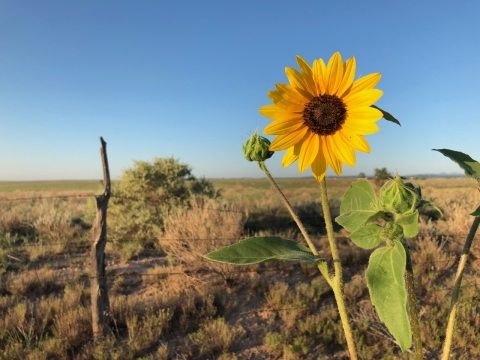The morning light has a new quality about it, somewhere between platinum and gold as summer starts its vanishing act in August. New Mexico’s summer monsoon showers tail off. We might get another blast of moisture in mid-September—but it is never the intensity of the afternoon cloudbursts that pour over us starting in July. Those first summer storms turn tawny prairies the color of a mule deer’s pelt to a refreshing blue-green akin to an algae-laden pond. Blue grama grass and neon-orange Indian paintbrush and lemony-yellow sunflowers soak it up.
Bright sunflowers along our rural roads south of Santa Fe where I live are monuments to the passing seasons. My home is on the edge of the piñon-juniper woods at 6,800 feet where the shortgrass prairie starts and bounds endlessly eastward through the gulf of the Plains States. Sunflowers first grow straight and fast and wiry to seven feet tall in July and put out leaves as big as hearty pancakes, coarse to the touch. They branch out in masse to what amounts to a bush come August and that is when the first blooms show themselves. When I see the yellow discs, I know then that change is coming. Even the most casual observer will note the progress of the season as measured by sunflowers.
What a joy it is to watch white, blue or multi-colored butterflies with the most curious of names—swallowtail, fritillary, sulfur, admiral, sister, cloak, and hairstreak—to flit about clusters of sunflowers like winged confetti in a roadside ticker-tape parade. They scatter in a flurry when I bicycle past them on my rural county gravel roads. Bees big and small land on the crayon-brown bulbous discs winged in yellow petals that will become autumn seed heads. Bees take a more staid and steady approach in pollinating plants. They earn dual credit with making amber honey and ensuring that plants reproduce. Bees always fly a little bit backwards first, as if to gain steam to zip off to the next stand of sunflowers.
Sunflowers year after year grace my rural routes in part by the actions of road graders, school buses, and snowplows that disturb the shoulders. How often do I see clusters of sunflowers on the prairie away from the roadside edge? Nearly never, save for a cattle wallow around a tank. It is a bit of a letdown to see their gleaming summer petals wilt and trend slowly toward an autumn hue like the cornhusks that swaddle tamales my family makes at Thanksgiving. By then the sunflowers are bony and brittle—completely exhausted crusty hulls of their former self—a bellwether that snow will soon fall.
The Stoics come to mind. Seasons come and seasons pass and children grow up. These ceaseless progressions remind any thinking being to enjoy what you have where you are right now—to “live immediately” as Seneca advised.
As fall comes on fully, the flowers that fed bees and butterflies nourish seed-eating birds. Lesser goldfinches dressed in black and lime-tinged yellow feathers migrating to warmer climes land on the dry brown casing of an exhausted sunflower, pinch out a few seeds and flit on toward Mexico with a hushed parting whisper as they take to the air. A school bus or snowplow in December will push leftover seeds into the gravelly roadside soil setting the stage for next August when sunflowers touch a domed cobalt sky while summer starts to slip away.
State Wildlife Grants Conserve Important Pollinators
Funding through the State Wildlife Grants (SWG) program, appropriated by Congress and administered by the U.S. Fish and Wildlife Service - Wildlife and Sport Fish Restoration, conserves species of greatest need identified in the State Wildlife Action Plans—12,000 rare and declining species across the United States. Pollinating insects are among them. Here are two examples:
The West Virginia Division of Natural Resources used SWG program funding to assess the threats and distribution of pollinators, particularly butterflies. This culminated in the West Virginia Atlas of Butterflies and Moths, providing an essential database for natural resource managers to evaluate threats and implement conservation measures.
The Wisconsin Department of Natural Resources started the Wisconsin Bumble Bee Brigade citizen science project to discover species distributions, habitat requirements, life cycles, and population status. The SWG program funded training and online resources to engage and retain citizen scientists in the endeavor. Volunteers dedicate particular interest in monitoring the Rusty Patched Bumble Bee, a federally endangered pollinator.
–Paul J. VanRyzin, Wildlife and Sport Fish Restoration






